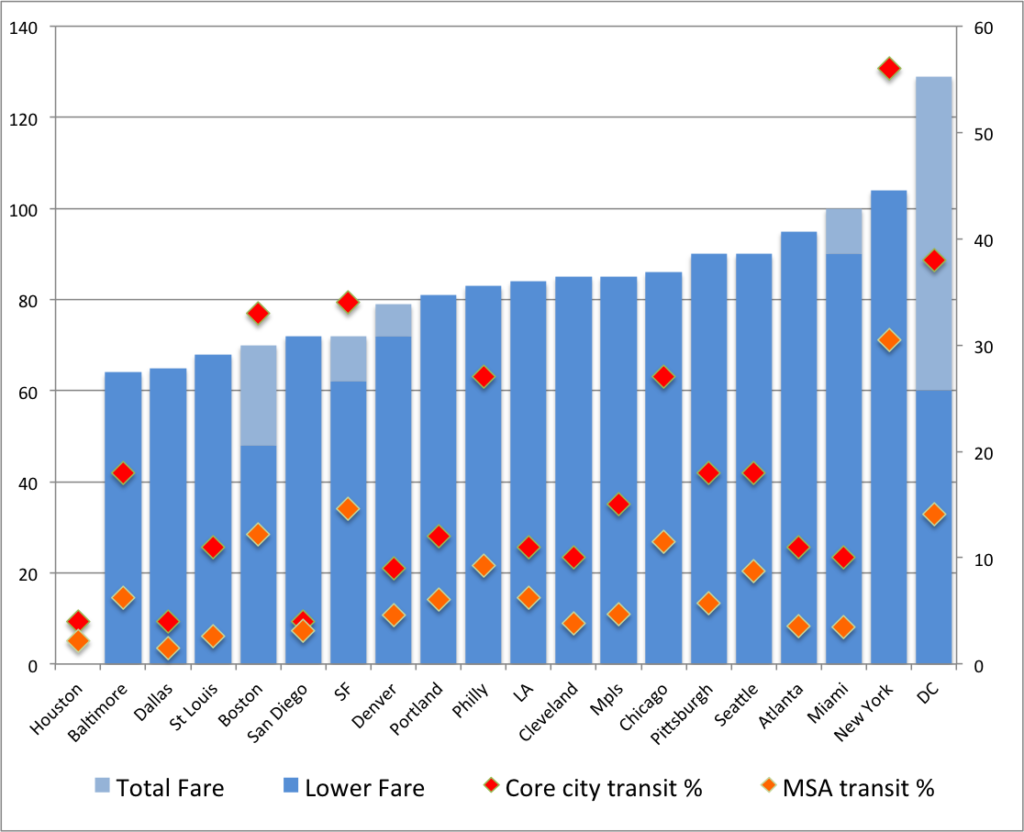According to the news, Occupy Boston has a new target: the MBTA. This is wrongheaded. They should protest the crawl with which the legislature is able (or unable) to make changes to the T’s funding mechanism, the debt burden shouldered by the agency from the Big Dig and myriad other poor decisions by the state and by the T in the last ten or twenty years. But protesting a modest fare increase? Not helpful.
Back in January, when the draconian proposals came out, my reaction was “well it must not be as bad as last time—then they were threatening to shut down commuter rail at 7 p.m.” Because of intransigence on the part of the legislature, the T has to threaten huge cuts, and then make smaller ones, so it’s a better pill to swallow. This time, at least, people seem to realize it’s a problem. Whether the legislature will act is another question all together.
In any case, the T will be raising fares to $2. Monthly passes will rise to $70. This is what the Occupy folks are protesting. And, well, this is really not a big deal. Look at other cities fares:
Only two cities have lower fares than Boston, and neither of these has a comparable level of transit. San Francisco does sell a cheaper pass for non BART-users, but those are confined to MUNI lines which are, well, not particularly speedy (the longest MUNI lines are about the distance from South Station to Alewife, but they take more than 22 minutes to complete the route). If you look at the “Big Six” cities with MSA transit use over 10% and center city transit use over 20% (Boston, SF, Philly, Chicago, DC and New York), the average monthly pass is about $85. DC has no real monthly pass option. And New York tops out over $100. Of course, their trains do run all night.
Here is another way of showing that the MBTA fares aren’t that high—looking at fares for major transit systems through the last 100 years in nominal and current dollars.
{“dataSourceUrl”:”//docs.google.com/spreadsheet/tq?key=0Aq40hr6FfrocdEk4Q21pS3V2eFVGeUw4NXVYdTBOMVE&transpose=0&headers=1&range=E1%3AO102&gid=0&pub=1″,”options”:{“vAxes”:[{“viewWindowMode”:”pretty”,”viewWindow”:{}},{“viewWindowMode”:”pretty”,”viewWindow”:{}}],”series”:{“0”:{“color”:”#1155cc”},”1″:{“color”:”#6d9eeb”},”2″:{“color”:”#cc0000″},”3″:{“color”:”#ea9999″},”4″:{“color”:”#ff9900″},”5″:{“color”:”#f9cb9c”},”6″:{“color”:”#38761d”,”lineWidth”:4},”7″:{“color”:”#00ff00″,”lineWidth”:4},”8″:{“color”:”#999999″},”9″:{“color”:”#cccccc”}},”useFormatFromData”:true,”booleanRole”:”certainty”,”curveType”:””,”height”:333,”animation”:{“duration”:500},”legend”:”in”,”theme”:”maximized”,”width”:600,”lineWidth”:2,”useFirstColumnAsDomain”:true},”state”:{},”chartType”:”LineChart”,”chartName”:”Chart 2″}
I left out DC (which has distance-based fares) and SEPTA (I couldn’t find fare history data for Philly) and threw in gas prices for fun. Note that the T has generally been about the same price as MUNI in San Francisco, and cheaper than Chicago and New York. (Except from 1920 to 1950, when Boston fares were a dime, and New York was a nickel.) The transit agencies all raise their fares to cope with increasing prices. And while the T has never hit the two dollar mark before, unless there’s deflation this year (there won’t be) it’s likely that prices will, in real terms, regress below the $2 mark in the next couple of years. It’s also significantly cheaper than New York and Chicago—especially since Chicago doesn’t have free bus transfers on single fares. And lest we complain further, Boston has had the lowest fare around since MUNI raised fares to $2 a couple years back.
Oh, and unless gas prices tumble real soon (and we’ll need another proper recession for that; in other words, we really don’t want cheap gas) any transit system is still cheaper than a gallon of petrol.
A few notes:
- New York has slight discounts—10% from 1993 to 2009, 7% since 2009, when purchasing at least $10 of transit fare. Chicago has charged between 10¢ and 30¢ for bus-train transfers since the 1960s.
- Since most transit users (about 2/3 in Boston) use monthly passes—an advent of the last 30 years or so—their actual fare per ride, assuming 2.5 rides per day for a transit-dependent user, is significantly lower: under a dollar in Boston. In transit-heavy New York, assuming 3 rides per day yields a cost per trip of just over a dollar.
- DC’s higher fares and lack of monthly passes yield a higher farebox recovery rate compared with other systems of over 60%.
- Commuter rail fares are going up, too, but for a less sensitive population: 28% of bus riders have incomes over $75,000, while 72% of Commuter Rail riders do.
- Data sources for Boston (Note that this study has transit fare comparisons in it, but doesn’t use the most-frequently-purchased fares; for instance it shows a single ride in New York as $2.50 and in Boston as $2. Most users pay less.), New York, Chicago, San Francisco. Gas prices from the EIA. Inflation from the BLS.


you are traveling DC to New York, you have to travel through Bus as i got
Cheap Bus Tickets.
Bus From NY to DC Package